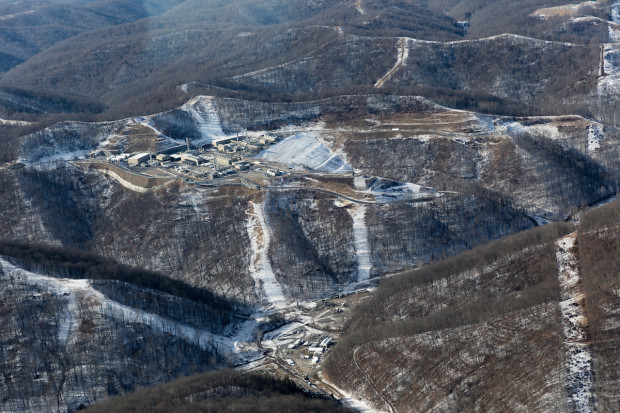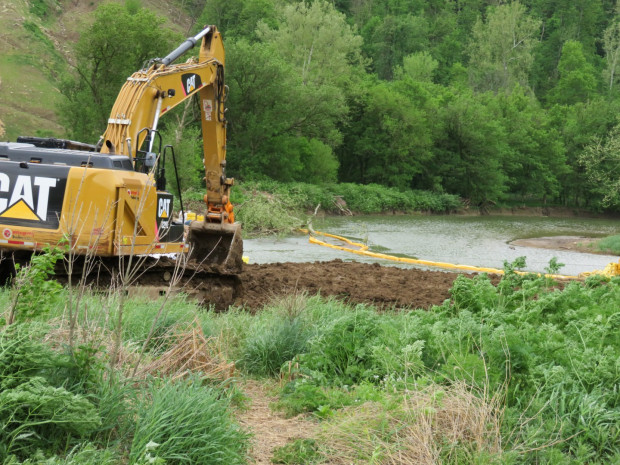In Ohio, the hellbender population is declining. Are pipelines affecting this ancient salamander?
-
Julie Grant/The Allegheny Front

18-year-old Theresa Paff cares for eastern hellbender salamanders at the Penta Career Center in Toledo, Ohio.
High school students in Nicole Costello’s small reptiles class at the Penta Career Center in Toledo, Ohio are learning firsthand how to foster an aquatic species that experts say is in decline: the eastern hellbender salamander.
In a bio-secured room on campus, 18-year-old Theresa Paff is among the students cleaning the glass tanks and cutting up worms to feed to the young Hellbenders they’re raising. “They always like to move, and they’re so slimy and slippery,” she says as she picks up a 3-year-old salamander in her care. “It’s really hard to hold.”
LISTEN: “Are Pipelines to Blame for Decline in Ancient Salamanders?”
The adults can get over two feet long and can live 35 years or more. They’re mainly found in streams along the Appalachian mountains in Pennsylvania and eastern Ohio. Lipps says hellbenders are tough; the species has survived for about a million years. That’s why Lipps was so concerned when he and a colleague found an 82-percent drop in their populations in Ohio. They just weren’t finding many young hellbenders. “It’s kind of like if the whole world became a nursing home overnight,” he says. “You know that the end is near if you don’t have any youngsters in these populations.”
Researchers suspect the problem has to do with increased sediment in the water. Young hellbenders are thought to live in little spaces in gravel beds, that are easily filled with sediment.
“It’s kind of like if the whole world became a nursing home overnight. You know that the end is near if you don’t have any youngsters in these populations.”
Lipps has watched as waterways, especially in the steep hills of eastern Ohio, near the Pennsylvania and West Virginia borders, have gotten muddier. The reason seems obvious to him: pipelines.
“It’s not rocket science when you see the muddy water to drive upstream until you see clear water and then figure out well, what’s happening, where’s the in between?” Lipps says. “And when I’ve done that it’s been pipeline construction.”
A view from above
To get a better picture of the gas pipeline boom here, Ted Auch of Fractracker organized a tour by plane of West Virginia and Ohio. Fracktracker is a non-profit that tracks the fracking industry.
Looking from the air, Auch is floored by how many hillsides are cleared of trees, to make way for pipelines. You can see gathering lines zigging and zagging, connecting every well pad and compressor station. Ohio and Pennsylvania are among the states with the most gathering lines in the country. Each state has more than 20,000 miles of them.
Pipeline companies are supposed to replant the pipeline corridors, but Auch says many don’t. He points out at an example on the ground. “...that’s all pipelines. And they have not hydro-seeded that, you see what I’m talking about?” he asks. ”And they’ve got that apron, that tarping material that’s supposed to prevent the loading of sediment down. But they didn’t hydroseed any of that.
On the ground in eastern Ohio, the hills are alive with pipeline construction. To the north, are the bigger transmission lines – the Mariner East and the Rover. Smaller gathering lines have names like the Hot Sauce Hustle, and Dr. Awkward.
Ohio State researcher Greg Lipps says when companies strip these steep hillsides of forest for pipelines, it can destroy his team’s efforts to restore streambanks, and protect the habitat for eastern hellbenders and other aquatic species. “What you create is effectively what can be a river of mud every time it rains. It’s really a problem. And the amount of silt and sediment that can come from a pipeline cut and from an eroding stream bank is immense,” he says.
66 pipeline crossings approved in one watershed
Many new pipelines also cross the streams themselves. One example of where this has been happening is Captina Creek, a high-quality stream and home to hellbenders. It empties into the Ohio River. Pipeline companies either bore underneath the stream bed or dig right through the water. According to an Allegheny Front review of applications to the Ohio Environmental Protection Agency, the state has issued at least 13 permits, including 66 pipeline stream crossings in the Captina Creek watershed alone since 2014. Harry Kallipolitis manages the Ohio EPA’s permitting process. His agency, as required by the Clean Water Act, certifies that pipeline crossings are not going to jeopardize the stream quality. “We evaluate what benefits to society it may have and weight that against the potential impacts to water quality,” he explains. “Our lower bar is not jeopardizing the existing use or how that stream is performing. And we do authorize the potential lowering of water quality with potential mitigation for that loss.”
There’s no regulation looking at the cumulative impacts of the new lines. But Kallipolitis says the EPA has not seen impacts on any streams from multiple pipeline crossings. “We evaluate a lot of streams in Ohio, and to my knowledge we haven’t had any of those reports come back to us and say that the stream is jeopardized by multiple crossings associated with pipeline projects,” he says.
The Ohio EPA says their 2009 study of the Captina Creek watershed, and additional water sampling in 2013, show no water quality issues of concern in Captina Creek. But the pipeline boom really started in this region around 2014, so those findings might not take the new stream crossings into account. Still, Kallipolitis says the Ohio EPA will propose new sediment regulations for pipelines in the coming months.
Looking for solutions to reduce pipeline impacts
Researchers at West Virginia University are starting to look at ways to reduce the environmental impacts of pipelines. Michael Strager, professor of resource economics, has gotten funding through the WVU Energy Institute to use GIS technology and drones to map pipelines in the region and match the locations with water quality data in nearby streams. “I think how our work is going to be useful is to really aid in the permitting process as part of a planning approach to direct this industry to places where we can potentially have less of an impact than others,” Strager says.
Like the students at Penta Career Center, the West Virginia researchers want the waterways clear enough so species like the eastern hellbenders can survive here. This summer, the high schoolers will release the young salamanders into the streams of eastern Ohio.


















